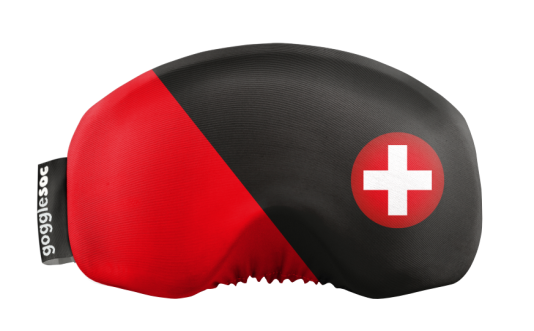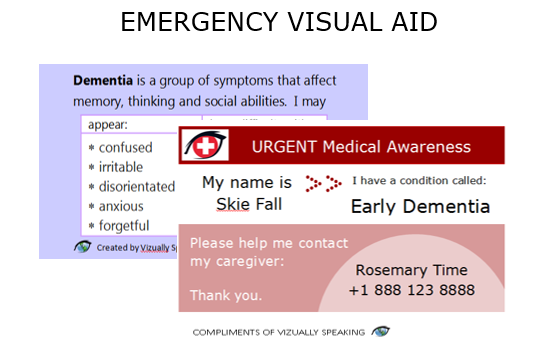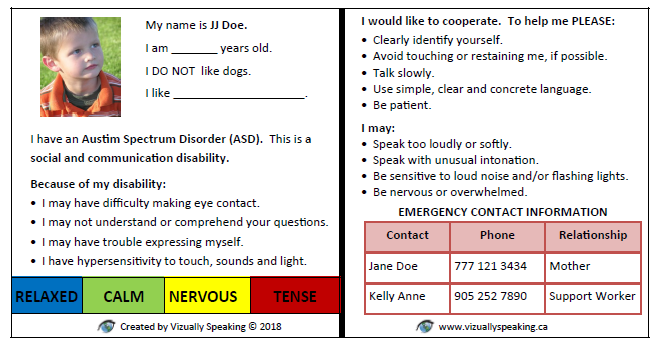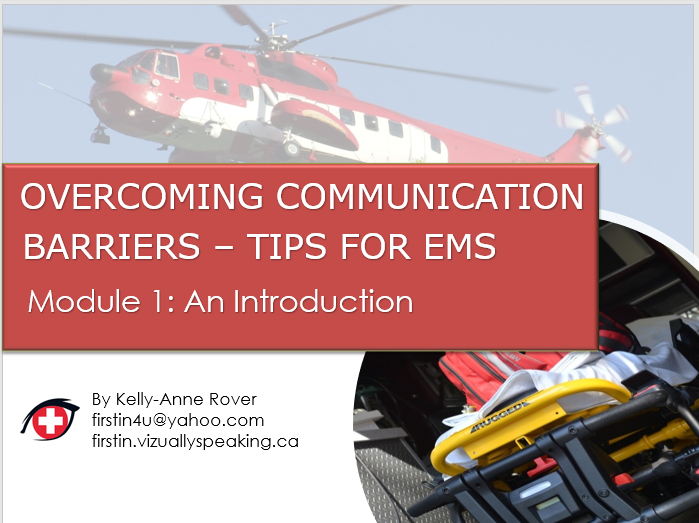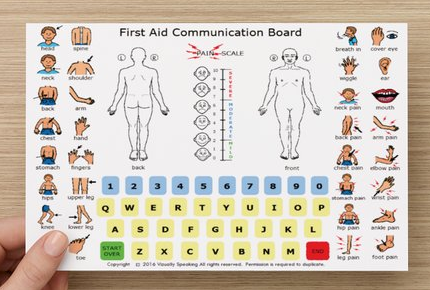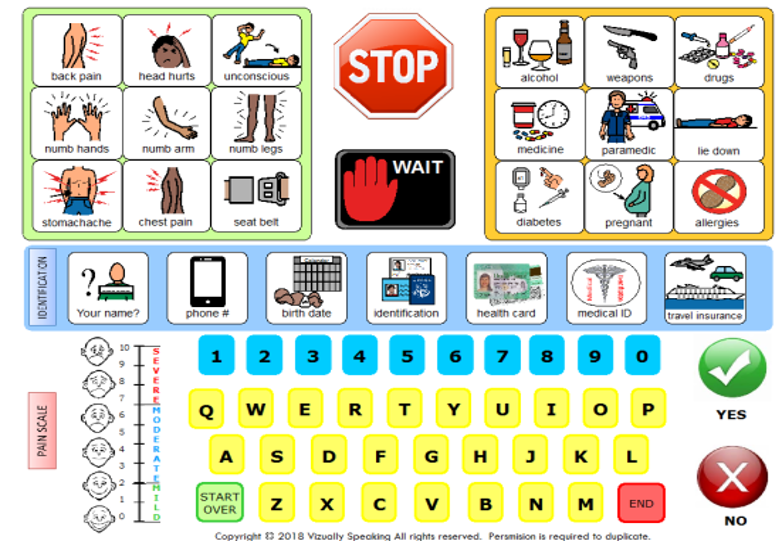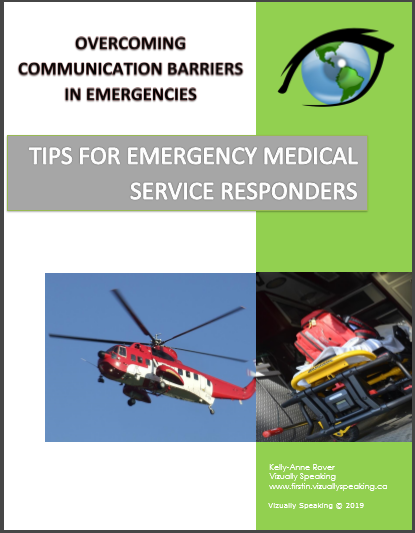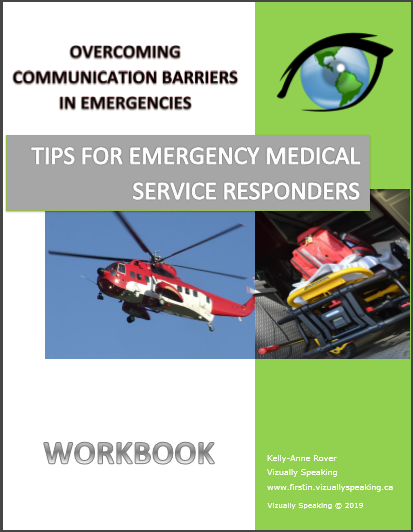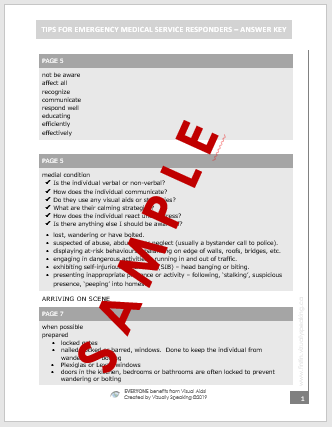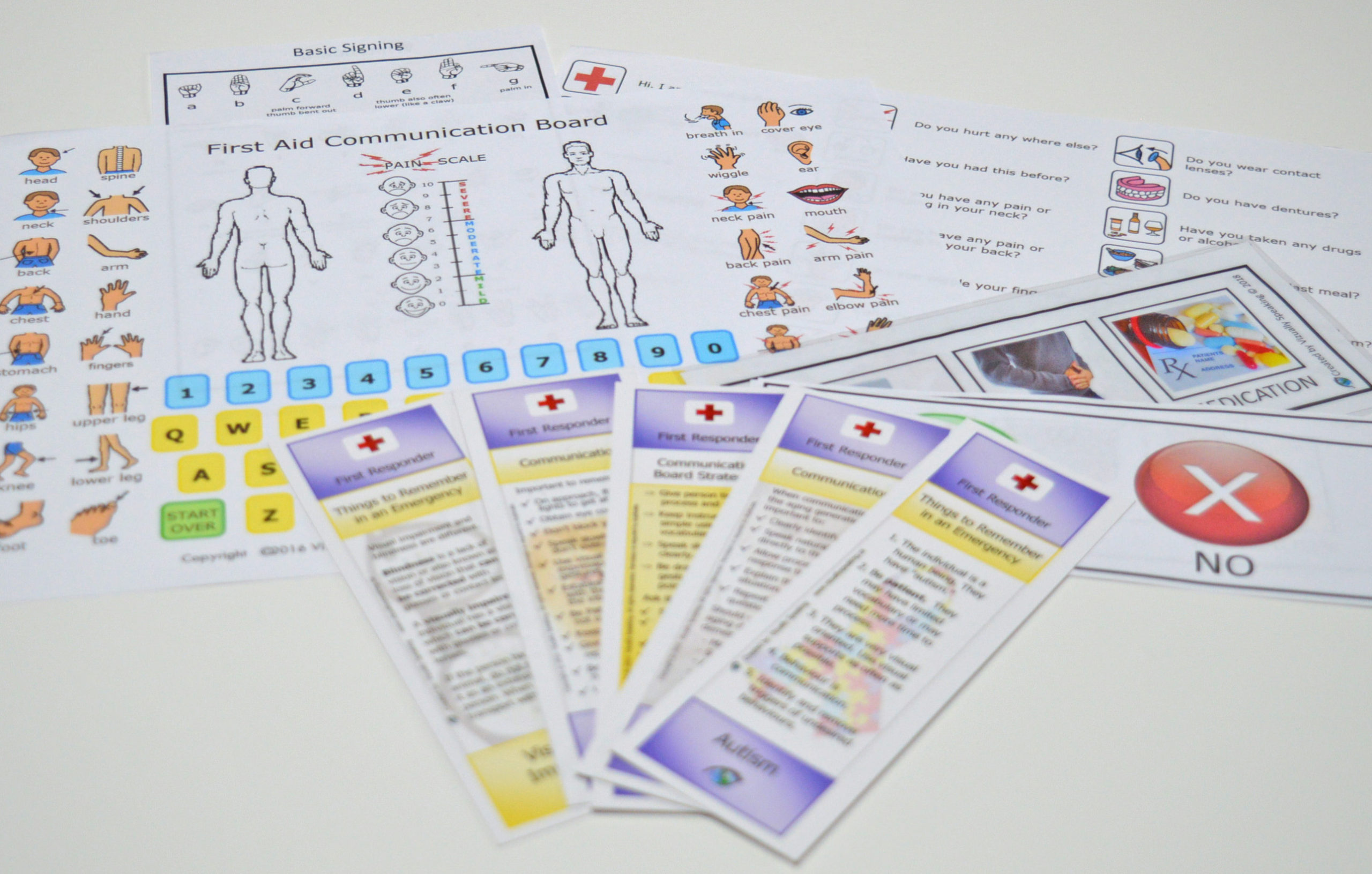EVERYONE benefits from visual aids!
Communication is the foundation of
our daily lives and a basic human right.

In response to an emergency, such as a medical emergency, an injured person, escalated behaviour, or an individual acting “weird”, “impaired”, “drunk”, “high” or “psychotic”, Emergency Medical Service Responders are often the first people at the scene. While attending to those involved in the emergency, they may not realize that the individual in crisis could have Autism, special needs, Dementia, a mental health condition, a brain injury, or maybe an English language learner. These medical conditions can affect people of all ages, genders, income levels, cultures, and ethnic backgrounds, and they are present in most countries. Often, these individuals cannot be identified by appearance alone.
Emergencies require efficient and effective communication between:
✓ First responder and patient
✓ Patient to first responder
✓ First responder to EMS
✓ EMS to first receivers in emergency rooms, hospitals, or shelters
Any communication breakdown can lead to misinformation which can result in:
- Unnecessary pain
- Misdiagnoses
- Error drug treatment
- Unnecessary long hospital stays
- Death
When the dispatcher is unable to provide this information, how will you react upon arriving at the scene? Are you prepared to handle a situation that is unique and unpredictable?
The Overcoming Communication Barriers in Emergencies – Tips for Emergency Medical Responders course enhances your awareness while educating you on how to identify, engage with, and overcome communication barriers that may arise during an emergency. It offers valuable information and resource tools to assist you when engaging with an individual who may have a disability, medical condition, identification, or does not speak English.
Learning how to effectively communicate and interact with individuals in crisis is the first step toward successfully managing an emergency.
ENROLL now in a course that will equip you with skills for a lifetime! Everyone benefits from visual aids!
EVERYONE benefits from visual aids!
Who’s it For?
ANYONE involved with Emergency Medical Services!
✓ Emergency Medical Services
✓ Paramedics (EMT-P/ACP)
✓ Emergency Medical
Attendants (EMA)
✓ Emergency Medical
Technicians (EMT)
✓ Emergency Medical
Technologists (EMT-P)
✓ Critical Care Paramedics
(CCP)
✓ Primary Care Paramedics
(PCP)
✓ Medical Transfer Attendants
✓ Emergency Medical Students
✓ Medical Attendants
✓ Ambulance Attendants
✓ Ambulance Drivers
✓ Patient Transfer Attendants
✓ Patient Transfer Drivers
✓ MedVents
✓ Medics
✓ Doctors
✓ Nurses
✓ Dentists
✓ Clinicians
✓ Therapists
✓ Volunteers
And more . . .
Who Benefits?
EVERYONE benefits from visual aids!
✓ Autism
✓ Acquired Brain Injruy (ABI)
✓ Traumatic Brain Injury (TBI)
✓ Learning Disabilities
✓ Stroke
✓ Previous Heard Injury
✓ Alzhemer’s
✓ Aphasia
✓ Cerebral Palsy
✓ Deaf, Hard of Hearing, or Hearing Impaired
✓ Dementia
✓ Developmental Delay
✓ Down Syndrome
✓ English as a Second Language
✓ Mental Illness
✓ Multiple Exceptionalities
✓ Mutism
✓ Poor Articulation
✓ Spoken Language Disorders
✓ A Lost of Frightened Child
And more . . .
Personalized Emergency Visual Aids
First In Vizually Speaking DESIGNS, CREATES, and TRAINS how to use personalized emergency visual aids and strategies. Contact us TODAY for your FREE consultation.
Learning Outcomes

How can you overcome communication barriers in emergencies? Through the use of research-based and peer-reviewed visual aids and strategies. Overcoming Communication Barriers in Emergencies – Tips for Emergency Medical Responders online, onsite, and virtual courses address establishing and obtaining accurate information while efficiently and effectively breaking down communication barriers that may arise during an emergency. You will uncover the benefits of using visual aids and strategies during an emergency and in daily life.
You will be introduced to the Emergency Medical Communication Board and the Emergency Responder Communication Board, two valuable communication and clarification tools. You will learn how to identify, effectively establish rapport, decrease undesired behaviours, and overcome communication barriers that may arise when engaging with an individual who may have Autism, special needs, mental health, Dementia, an identification, a diagnosis, a brain injury, or is an English Language Learner (ELL) or speaks English as Second Language (ESL).
The material used during these training modules and in the creation of each course book and workbook (including an answer key) have been designed under the guidelines of the Accessibility for Ontarians with Disabilities Act (AODA) 2015 Accessibility regulations, school boards inclusions policies and takes into consideration various learning styles.
If you have any questions, are interested in further training, or require visual aids and strategies designed specifically for you, contact us TODAY!
EVERYONE benefits from visual aids!
Goals
Upon completion, the participant will be able to:

- Identify and communicate with a person with autism, special needs, mental health, Dementia, an identification, a brain injury, a diagnosis, or an English Language Learner (ELL) or speaks English as a Second Language (ESL) in an emergency.
- Recognize Augmentative and Alternative Communication (AAC) and clarification strategies to enhance effective and efficient communication during an emergency.
- Use the Emergency Medical Responder and Emergency Responder Communication Board to accurately obtain and clarify information in an emergency.
- Use clarification strategies to communicate and acquire information during an emergency.
- Understand and recognize the benefits of using visual aids and strategies in an emergency and everyday life.
EVERYONE benefits from visual aids!
NEW Online Course
Visual aids transcend generations, education levels, and cultures.
The Overcoming Communication Barriers in Emergencies – Tips for Emergency Medical Responders online course contains comprehensive information about visual aids and strategies divided into nineteen short easy-to-digest modules. Each module includes a FREE downloadable presentation PDF (so you can make notes while learning) and short review questions giving you an in-depth understanding of the various topics and strategies used when responding to different accidents and emergencies.
Learning how to effectively communicate and interact with individuals in crisis is the first step toward successfully managing an emergency. This ensures your patient to feel they are in the best available care.
What you will learn with the Tips for Emergency Medical Responders online course:
Module 1: Introduction
Module 2: Communication Barriers
Module 3: Arriving on Scene
Module 4: Identification Clues
Module 5: Missing Person
Module 6: Communication
Module 7: Communication Boards
Module 8: Technology & Devices
Module 9: Emergency Medical Responder Communication Board
Module 10: COVID-19 & Variants
Module 11: Clarification Strategies
Module 12: Behaviour
Module 13: Gathering Information
Module 14: Response Modifications
Module 15: Examination Tips
Module 16: In Case of Seizures
Module 17: Restraints
Module 18: Transportation
Module 19: Autism
This online course will provide you with training and knowledge that will last a lifetime.
ENROLL now for your success!
First In Vizually Speaking provides onsite and virtual training tailored to meet any group’s needs.
Online Course Requirements
NONE
You can visit First In Vizually Speaking’s online course menu for more great courses like this.
ENROLL TODAY!
EVERYONE benefits from visual aids!
Course Materials

The material used during these training modules and in the creation of each course book and workbook (including an answer key) have been designed under the guidelines of the Accessibility for Ontarians with Disabilities Act (AODA) 2015 Accessibility regulations, school boards inclusions policies and takes into consideration various learning styles.
- Online modules – Emergency Medical Responders
- eWorkbook – Student – Emergency Medical Responders
- PDF of each module
- Certificate of Completion
Online Certification

Copyright © 2022 Vizually Speaking
All Rights Reserved. Permission is required to duplicate.
If you require a certificate of completion, simply complete the short online Quiz. This quick review highlights what you have learned through the Overcoming Communication Barriers in Emergencies – Tips for Emergency Medical Responders online course. A certificate of completion will be given to participants who achieve 80% or higher.
EVERYONE benefits from visual aids!
** Also available for an additional cost **
Join the Conversation
Have you responded to an emergency with an individual who has Autism, special needs, mental health, Dementia, an identification, a diagnosis, a brain injury, or is an English Language Learner (ELL) or speaks English as a Second Language (ESL)? What was the greatest challenge you faced? How did you resolve it?
Join the conversation on Facebook, “The greatest challenge I’ve faced when responding to an individual with Autism, special needs, mental health, Dementia, an identification, a diagnosis, a brain injury or was an English Language Learner (ELL) or speaks English as a Second Language (ESL) in an emergency was __________________________.”
EVERYONE benefits from visual aids!

Legal Disclaimer
This site is solely owned and operated by First In Vizually Speaking.
Owner/Operator
The information on this site is for informational purposes only. First In Vizually Speaking assumes no liability for any inaccurate, misleading, false, or incomplete information therein, nor for any actions taken in reliance thereon.
General Website Content
First In-Vizually Speaking makes every effort to ensure that the information on this site is accurate and reliable but cannot guarantee that it is error-free or complete. Information provided on firstin.vizuallyspeaking.com is for general informational purposes only, it is not offered as and does not constitute medical advice. In no way are any materials presented meant to be a substitute for professional medical care or attention by a qualified practitioner, nor should they be construed as such. Please report outdated or inaccurate information to us.
First In Vizually Speaking does not endorse any product, treatment, or therapy; neither does it evaluate the quality of services that may be referred to on this site. Any 3rd party offering or advertising on firstin.vizuallyspeaking.com does not constitute an endorsement by First In-Vizually Speaking.
Contact us today for more information:
TUMBLER RIDGE, B.C., CANADA


